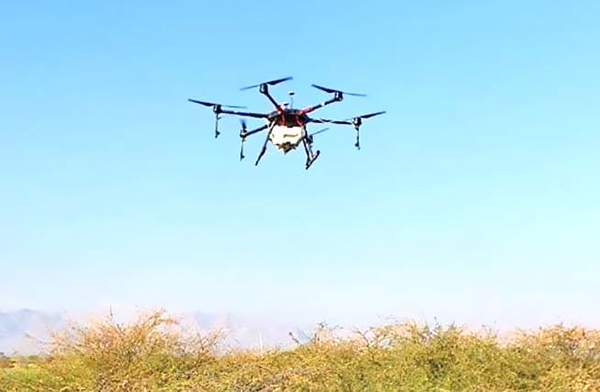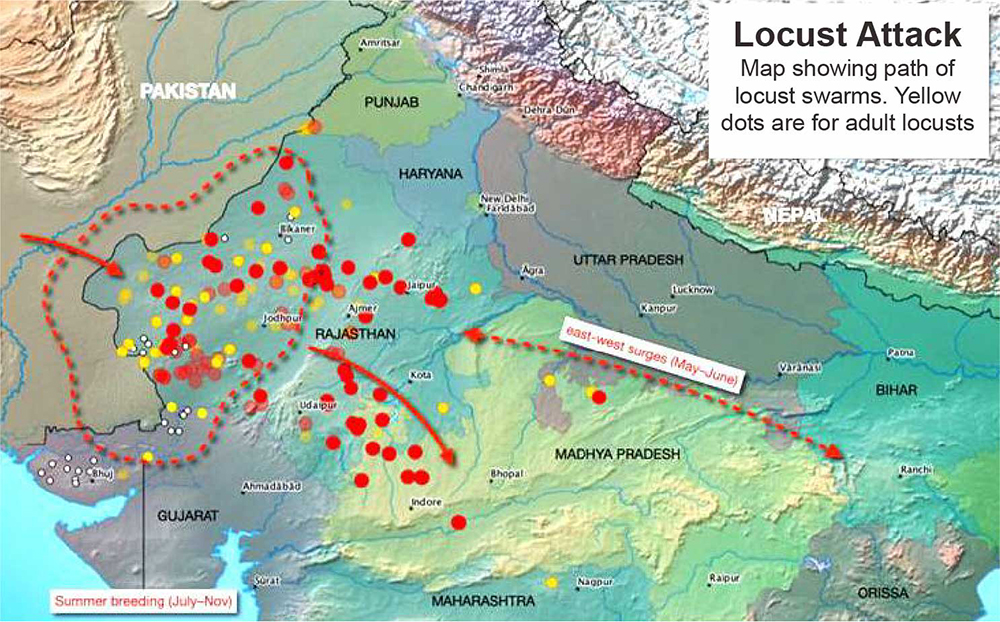
Swarms of locusts invaded vast swathes of land in India from 11 April. Several districts of Rajasthan and Madhya Pradesh were affected. Many districts in Uttar Pradesh were put on alert.
Locusts in large numbers cause severe damage to standing crops, completely obliterate the yield thereby resulting in massive losses to farmers and causing food shortages in the country.
This locust attack affected about 90,000 hectares across 20 districts in Rajasthan threatening to amplify into an agrarian disaster.
Last year, mature locusts had entered parts of India after a gap of 26 years, but the locusts that came in this year were immature. Immature locusts are not fully grown and have the capacity to cause more harm. They also have a longer lifespan.
810 tractor mounted sprayers,120 survey vehicles, 89 fire brigades for pesticide spray, 47 control vehicles with spray equipment were deployed for effective locust control, as per requirement on different days by the Ministry of Agriculture and Farmer’s Welfare.
As locust swarms make inroads, the central government, in a possible first, allowed the contingent use of remotely piloted aircraft systems (RPAS), or drones, for spraying pesticides to check the dreaded pests.
The agriculture ministry’s directorate for plant protection, quarantine and storage gave given indemnity to use battery-operated rotary-wing drones for aerial surveillance, public announcements, photography and/or aerial spraying of anti-locust pesticides provided at no time it posed a threat to crops, livestock, property or any other manned/unmanned aircraft.
Operating Procedure
The Ministry of Civil Aviation, in an order dated May 21, in exercise of powers conferred under Rule 160 of the Aircraft Rules, 1937, provides “conditional exemption” to Ministry of Agriculture and Farmers Welfare,” to use RPAS – as drones are more formally known – to spray pesticide and in aerial surveillance and photography, specifically in “anti-locust” measures. The civil aviation ministry’s conditional exemption is applicable only for rotary wing drones not exceeding 25 kg.
The Faridabad-based Directorate of Plant Protection, Quarantine and Storage (DPPQS) was made the nodal agency for use of drones in combating the locust swarms. The DPPQS was allowed to operate its own drones or work with third-party service providers to cover as much of the affected area as possible.
To avoid delays in their deployment, the agency uploaded details of every flight and pesticide sprayed within seven days of drone flights. No prior permission was needed.
The drones were required to have a Unique Identification Number (UIN) or Drone Acknowledgment Number (DAN), as per the order. India has granted DANs to around 20,000 drones so far.
The move came soon after the government fast-tracked approvals for drone use in aerial surveillance and photography by its departments to fight the Covid-19 pandemic.
The civil aviation ministry has launched a portal, GARUD, for the same, and has permitted drone deployments even in densely populated urban areas.
The twin approvals could also set the stage for India coming up with progressive guidelines on drone use by civilians, said industry players. This could also boost the local drone industry, which has faced delays in getting various approvals from the government.
Why are locusts a problem?
Globally, climate scientists are decrying the changes caused by climate change which they claim are behind the current infestations, hitting Sudan, parts of Iran, Pakistan and Africa at large.
Warmer seas have resulted in a surge in the frequency of cyclones in the Indian Ocean. This caused heavy downpours along the Arabian peninsula, creating ideal conditions for locust breeding in the deserts of Yemen, Oman and Saudi Arabia.
The impact on a country’s food supply could be enormous. As per figures released by the Food and Agricultural Organization (FAO), a locust swarm of a square kilometer is able to eat the same amount of food in one day as 35,000 people.
Researchers are increasingly looking to technology like drones to help provide early warning signs and control locust outbreaks amid fears climate change could bring more cyclones.
Limits of Drone Usage
Existing drone models are limited in terms of the volumes they can carry and the distances they can cover due to their limited battery life and size, say entomologists and plant protection researchers.
Another challenge for drone use in such emergencies is the lack of workable and feasible regulation. Most countries including India are still in the early stages of drafting laws, prohibiting usage unless in exceptional circumstances and with strict approvals.
That makes it harder to deploy larger drones, which have petrol-powered engines capable of carrying tanks of up to 1800liters and travelling distances of up to 750 km, since they often require singular approval.
Drones can also be used in the aftermath of an infestation.
The other case to be made for drones is in post disaster mapping. Governments need to know the extent of the damage afterwards. Combining larger satellite maps with smaller drone maps – which provide higher resolution images – will give a more accurate assessment on the health of the crops and the extent of crop loss.
Drone Business in India
The Indian unmanned aerial vehicles (UAV) market is poised to grow at a CAGR of 18% during 2017–23 in terms of revenue (PwC report). Although these numbers will continue to be led by the longer range UAV segments, medium and mini-UAVs are also poised to register a healthy margin of growth.
Drone startups in India do not have clear use case or solutions in mind. They need to offer solutions rather than continue to churn out drones with higher specifications than what is available in the market.
On the international side, The United Nations is all set to test drones equipped with mapping sensors and atomizers to spray pesticides in parts of East Africa which is battling an invasion of desert locusts and exacerbating the hunger crisis in the region.
Indian drone manufacturers need to up their game if they want to continue to compete on an international scale and help solve the key stumbling blocks the nation will inevitably face in the aftermath of the pandemic.
Drones Help During Pandemic
The Covid-19 crises brought out various use cases of drones in India. Whether it was for aerial surveillance, delivery of medical essentials or spraying disinfectants, drones have come in handy in various ways. Startups like Garuda Aerospace, Redwing Aerospace, Indian Robotics Solutions and Idea Forge have been running their specialised projects in partnership with local authorities in different parts of the country.
Drones are being used by media organizations to shoot videos or click photographs and cover various aspects of the lockdown. Drones are being used by local governments and municipalities to broadcast messages and information about lockdown measures, especially in rural areas that lack open communication channels for health information. Drones equipped with loudspeakers are being used to make public announcements to keep people indoors, take necessary precautions, and ensure social-distancing norms and use of a mask when stepping outside of home in urban areas.
In some cities, governments have been using drones to monitor people’s movement and break up social gatherings that could pose a risk to society. To disinfect public spaces and check the further spread of Covid-19, health officials are deploying agriculture spray drones to carry out imperative tasks like spraying disinfectant in potentially affected areas. Hospitals and doctors in critical need of medical supplies and laboratory testing more than ever believe drones are the safest and fastest ways to deliver medical supplies and transport samples from hospitals to laboratories. Countries like China, India, Indonesia, Philippines, Colombia, Chile, and the UAE have successfully used disinfecting drones to effectively address concerns borne from the pandemic. Apart from medical supplies, drones are also being used to deliver groceries in some parts of China, the US, and Australia.
Alphabet Inc., Google’s parent company has been successfully using its wing drones to deliver food and medicine during the coronavirus pandemic. Alphabet’s subsidiary, ‘Project Wing’, the drone delivery service launched in 2019 said it had seen a “dramatic” increase in customers using the service during the lockdown.


















